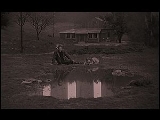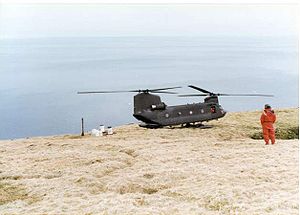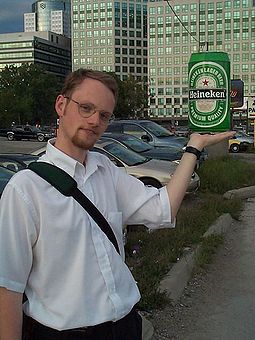
Forced perspective
Encyclopedia

Optical illusion
An optical illusion is characterized by visually perceived images that differ from objective reality. The information gathered by the eye is processed in the brain to give a perception that does not tally with a physical measurement of the stimulus source...
to make an object appear farther away, closer, larger or smaller than it actually is. It is used primarily in photography
Photography
Photography is the art, science and practice of creating durable images by recording light or other electromagnetic radiation, either electronically by means of an image sensor or chemically by means of a light-sensitive material such as photographic film...
, filmmaking
Filmmaking
Filmmaking is the process of making a film, from an initial story, idea, or commission, through scriptwriting, casting, shooting, directing, editing, and screening the finished product before an audience that may result in a theatrical release or television program...
and architecture
Architecture
Architecture is both the process and product of planning, designing and construction. Architectural works, in the material form of buildings, are often perceived as cultural and political symbols and as works of art...
. It manipulates human
Human
Humans are the only living species in the Homo genus...
visual perception
Visual perception
Visual perception is the ability to interpret information and surroundings from the effects of visible light reaching the eye. The resulting perception is also known as eyesight, sight, or vision...
through the use of scaled objects and the correlation between them and the vantage point of the spectator or camera.
Forced perspective in filmmaking
Examples of forced perspective:- A scene in an action/adventure movie in which dinosaurs are threatening the heroes. By placing a miniature model of a dinosaur close to the camera, the dinosaur may look monstrously tall to the viewer, even though it is just closer to the camera.
Movies (especially B-movie
B-movie
A B movie is a low-budget commercial motion picture that is not definitively an arthouse or pornographic film. In its original usage, during the Golden Age of Hollywood, the term more precisely identified a film intended for distribution as the less-publicized, bottom half of a double feature....
s) in the 1950s and 1960s produced on limited budgets sometimes feature forced perspective shots which are completed without the proper knowledge of the physics of light used in cinematography, so foreground models can appear blurred or incorrectly exposed.
Forced perspective can be made more believable when environmental conditions obscure the difference in perspective. For example, the final scene of the famous movie Casablanca
Casablanca (film)
Casablanca is a 1942 American romantic drama film directed by Michael Curtiz, starring Humphrey Bogart, Ingrid Bergman and Paul Henreid, and featuring Claude Rains, Conrad Veidt, Sydney Greenstreet, Peter Lorre and Dooley Wilson. Set during World War II, it focuses on a man torn between, in...
takes place at an airport in the middle of a storm, although the entire scene was shot in a studio. This was accomplished by using a painted backdrop of an aircraft, which was "serviced" by dwarfs
Dwarfism
Dwarfism is short stature resulting from a medical condition. It is sometimes defined as an adult height of less than 4 feet 10 inches , although this definition is problematic because short stature in itself is not a disorder....
standing next to the backdrop. A downpour (created in-studio) draws much of the viewer's attention away from the backdrop and extras, making the simulated perspective less noticeable.
Role of light
Early instances of forced perspective used in low-budget motion pictures showed objects that were clearly different from their surroundings: often blurred or at a different light level. The principal cause of this was geometric. Light from a point sourcePoint source
A point source is a localised, relatively small source of something.Point source may also refer to:*Point source , a localised source of pollution**Point source water pollution, water pollution with a localized source...
travels in a spherical wave, decreasing in intensity (or illuminance
Illuminance
In photometry, illuminance is the total luminous flux incident on a surface, per unit area. It is a measure of the intensity of the incident light, wavelength-weighted by the luminosity function to correlate with human brightness perception. Similarly, luminous emittance is the luminous flux per...
) as the inverse square of the distance travelled. This means that a light source must be four times as bright to produce the same illuminance at an object twice as far away. Thus to create the illusion of a distant object being at the same distance as a near object and scaled accordingly, much more light is required.
Opening the camera's iris
Diaphragm (optics)
In optics, a diaphragm is a thin opaque structure with an opening at its center. The role of the diaphragm is to stop the passage of light, except for the light passing through the aperture...
lets more light into the camera, allowing both near and far objects to be seen at a more similar light level, but this has the secondary effect of decreasing depth of field
Depth of field
In optics, particularly as it relates to film and photography, depth of field is the distance between the nearest and farthest objects in a scene that appear acceptably sharp in an image...
. This makes either the near or the far objects appear blurry. By increasing the volume of light hitting the distant objects, the iris opening can be restricted and depth of field is increased, thus portraying both near and far objects as in focus, and if well scaled, existing in a similar lateral plane.
Since miniature models would need to be subjected to far greater lighting than the main focus of the camera, the area of action, it is important to ensure that these can withstand the significant amount of heat generated by the incandescent light sources typically used in film and TV production.
Nodal point: forced perspective in motion
Peter JacksonPeter Jackson
Sir Peter Robert Jackson, KNZM is a New Zealand film director, producer, actor, and screenwriter, known for his The Lord of the Rings film trilogy , adapted from the novel by J. R. R...
's film adaptations of The Lord of the Rings
The Lord of the Rings
The Lord of the Rings is a high fantasy epic written by English philologist and University of Oxford professor J. R. R. Tolkien. The story began as a sequel to Tolkien's earlier, less complex children's fantasy novel The Hobbit , but eventually developed into a much larger work. It was written in...
make extended use of forced perspective. Characters apparently standing next to each other would be displaced by several feet in depth from the camera. This, in a still shot, makes some characters appear much smaller (for the dwarves
Dwarf (Middle-earth)
In the fiction of J. R. R. Tolkien, the Dwarves are a race inhabiting the world of Arda, a fictional prehistoric Earth which includes the continent Middle-earth....
and Hobbit
Hobbit
Hobbits are a fictional diminutive race who inhabit the lands of Middle-earth in J. R. R. Tolkien's fiction.Hobbits first appeared in the novel The Hobbit, in which the main protagonist, Bilbo Baggins, is the titular hobbit...
s) in relation to others.
A new technique developed for The Lord of the Rings: The Fellowship of the Ring was an enhancement of this principle which could be used in moving shots. Portions of sets were mounted on movable platforms which would move precisely according to the movement of the camera, so that the optical illusion would be preserved at all times for the duration of the shot. The same techniques were used in the Harry Potter
Harry Potter
Harry Potter is a series of seven fantasy novels written by the British author J. K. Rowling. The books chronicle the adventures of the adolescent wizard Harry Potter and his best friends Ron Weasley and Hermione Granger, all of whom are students at Hogwarts School of Witchcraft and Wizardry...
movies to make the character Hagrid look like a giant. Props around Harry and his friends are of normal size, while seemingly identical props placed around Hagrid are in fact smaller.
The techniques developed center around a nodal point axis, so the camera's panning axis is at the point between the lens and aperture ring where the light travelling through the camera meets its axis. By comparison, the normal panning axis would be at the point at which light would strike the film (or image sensor
Image sensor
An image sensor is a device that converts an optical image into an electronic signal. It is used mostly in digital cameras and other imaging devices...
in a digital camera).
The position of this nodal point can be different for every lens. However, on wide angle lenses it is often found between the midpoint of the lens and the aperture ring.
"Comedic" effects

The 1930 Laurel and Hardy
Laurel and Hardy
Laurel and Hardy were one of the most popular and critically acclaimed comedy double acts of the early Classical Hollywood era of American cinema...
movie Brats
Brats
Brats is a 1930 Laurel and Hardy comedy short. The film was directed by James Parrott. Laurel and Hardy play dual roles as their own children....
used forced perspective to depict Stan
Stan Laurel
Arthur Stanley "Stan" Jefferson , better known as Stan Laurel, was an English comic actor, writer and film director, famous as the first half of the comedy team Laurel and Hardy. His film acting career stretched between 1917 and 1951 and included a starring role in the Academy Award winning film...
and Ollie
Oliver Hardy
Oliver Hardy was an American comic actor famous as one half of Laurel and Hardy, the classic double act that began in the era of silent films and lasted nearly 30 years, from 1927 to 1955.-Early life:...
simultaneously as adults and as their own sons.
An example used for comic effect can be found in the slapstick comedy Top Secret!
Top Secret!
Top Secret! is a 1984 comedy film directed by David Zucker, Jim Abrahams, and Jerry Zucker. It stars Val Kilmer , Lucy Gutteridge, Omar Sharif, Peter Cushing, Michael Gough and Jeremy Kemp. The film is a parody of the GDR era and Elvis films...
in a scene which appears to begin as a close up of a ringing phone with the characters in the distance. However when the character walks up to the phone (towards the camera) and picks it up it becomes apparent that the phone is extremely oversized instead of being close to the camera. Another scene in the same movie begins with a closeup of a wristwatch. The next cut shows that the character actually has a gargantuan wristwatch.
The same technique is also used in the Dennis Waterman
Dennis Waterman
Dennis Waterman is a British actor and singer, best known for his tough-guy roles in television series including The Sweeney, Minder and New Tricks.-Early life:...
sketch in the British BBC
BBC
The British Broadcasting Corporation is a British public service broadcaster. Its headquarters is at Broadcasting House in the City of Westminster, London. It is the largest broadcaster in the world, with about 23,000 staff...
sketch show Little Britain
Little Britain
Little Britain is a British character-based comedy sketch show which was first broadcast on BBC radio and then turned into a television show. It was written by comic duo David Walliams and Matt Lucas...
. In the television version, oversized props are used to make the caricatured Waterman look just three feet tall or less.
In The History of the World, Part I, while escaping the French peasants, Mel Brooks' character, Jacques, who is doubling for King Louis, runs down a hall of the palace, which turns into a ramp, showing the smaller forced perspective door at the end. As he backs down into the normal part of the room, he mutters, "Who designed this place?"
One of the recurring The Kids in the Hall
The Kids in the Hall
The Kids in the Hall is a Canadian sketch comedy group formed in 1984, consisting of comedians Dave Foley, Kevin McDonald, Bruce McCulloch, Mark McKinney, and Scott Thompson. Their eponymous television show ran from 1988 to 1994 on CBC in Canada, and 1989 to 1995 on CBS and HBO in the United States...
sketches featured Mr. Tyzik, "The Headcrusher", who used forced perspective (from his own point of view) to "crush" other people's heads between his fingers.
In the making of Season 5 of Red vs. Blue
Red vs. Blue
Red vs. Blue, often abbreviated as RvB, is a set of related comic science fiction video series created by Rooster Teeth Productions and distributed through the Internet and on DVD...
, the creators used forced perspective to make the character of Tucker's baby look small. In fact in the game, the alien character used as the baby is the same height as other characters.
Forced perspective in architecture
In architectureArchitecture
Architecture is both the process and product of planning, designing and construction. Architectural works, in the material form of buildings, are often perceived as cultural and political symbols and as works of art...
, a structure can be made to seem larger, taller, farther away or otherwise by adjusting the scale
Scale (ratio)
The scale ratio of some sort of model which represents an original proportionally is the ratio of a linear dimension of the model to the same dimension of the original. Examples include a 3-dimensional scale model of a building or the scale drawings of the elevations or plans of a building. In such...
of objects in relation to the spectator, increasing or decreasing perceived depth.
For example, when forced perspective is used to make an object appear farther away, the following method can be used: By constantly decreasing the scale of objects from expectancy and convention toward the farthest point from the spectator, an illusion is created that the scale of said objects is decreasing due to their distant location. In contrast, the opposite technique was sometimes used in classical garden designs and other "follies" to shorten the perceived distances of points of interest along a path.
The Statue of Liberty
Statue of Liberty
The Statue of Liberty is a colossal neoclassical sculpture on Liberty Island in New York Harbor, designed by Frédéric Bartholdi and dedicated on October 28, 1886...
is built with a slight forced perspective so that it appears more correctly proportioned when viewed from its base. When the statue was designed in the late 19th century (before easy air flight), there were few other angles from which to view the statue. This caused a difficulty for special effects technicians working on the movie Ghostbusters II
Ghostbusters II
Ghostbusters II is a 1989 science fiction comedy film produced and directed by Ivan Reitman. It is the sequel to the 1984 film Ghostbusters and follows the further adventures of a group of parapsychologists and their organization which combats paranormal activities...
, who had to back off on the amount of forced perspective used when replicating the statue for the movie so that their model (which was photographed head-on) would not look top-heavy. This effect can also be seen in Michelangelo's statue of David
David (Michelangelo)
David is a masterpiece of Renaissance sculpture created between 1501 and 1504, by the Italian artist Michelangelo. It is a marble statue of a standing male nude. The statue represents the Biblical hero David, a favoured subject in the art of Florence...
.
Forced perspective is extensively employed at theme parks and other such architecture as found in Disneyland
Disneyland Park (Anaheim)
Disneyland Park is a theme park located in Anaheim, California, owned and operated by the Walt Disney Parks and Resorts division of the Walt Disney Company. Known as Disneyland when it opened on July 18, 1955, and still almost universally referred to by that name, it is the only theme park to be...
and Las Vegas
Las Vegas, Nevada
Las Vegas is the most populous city in the U.S. state of Nevada and is also the county seat of Clark County, Nevada. Las Vegas is an internationally renowned major resort city for gambling, shopping, and fine dining. The city bills itself as The Entertainment Capital of the World, and is famous...
, often to make structures seem larger than they are in reality where physically larger structures would not be feasible or desirable or to provide an optical illusion for entertainment value.
See also
- Ames roomAmes roomAn Ames room is a distorted room that is used to create an optical illusion. Probably influenced by the writings of Hermann Helmholtz, it was invented by American ophthalmologist Adelbert Ames, Jr...
- Perspective distortion (photography)Perspective distortion (photography)In photography and cinematography, perspective distortion is a warping or transformation of an object and its surrounding area that differs significantly from what the object would look like with a normal focal length, due to the relative scale of nearby and distant features...
- Special effects of The Lord of the Rings film trilogySpecial effects of The Lord of the Rings film trilogyThe Lord of the Rings film trilogy used many groundbreaking practical and digital visual effects. The first film has around 540 effects shots, the second 799, and the third 1488 . The total moves up to 3420 with the Extended cuts. 260 visual effects artists worked on the trilogy, and the number...
, the first film to use a moving camera in a forced perspective shot - Optical illusionOptical illusionAn optical illusion is characterized by visually perceived images that differ from objective reality. The information gathered by the eye is processed in the brain to give a perception that does not tally with a physical measurement of the stimulus source...
- AnamorphosisAnamorphosisAnamorphosis or anamorphism may refer to any of the following:*Anamorphosis, in art, the representation of an object as seen, for instance, altered by reflection in a mirror...

